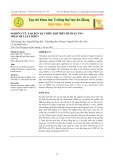
Organic matter removal
-
This study aims to investigate the fouling mechanism, which mostly impacts the water permeability via empirical modeling. Normally, there are four different physical-based types of fouling: complete blocking, intermediate blocking, cake filtration and standard blocking or adsorption.
 7p
7p  viyoko
viyoko
 24-09-2024
24-09-2024
 1
1
 1
1
 Download
Download
-
The research herein builds on the work of Rojek (2003) and further investigates the bioremediation of NOM wastes. The aim of this research was to evaluate the effectiveness of selected white-rot fungi and yeast for the biodegradative removal of concentrated NOM from solution. The effectiveness of the white-rot fungus P. chrysosporium ATCC 34541 for the biological degradation of different batches of MIEXTM NOM concentrate and the effects of different characteristics of the NOM on the process and thus the resistance of the NOM to microbial removal were investigated.
 131p
131p  runthenight05
runthenight05
 01-03-2023
01-03-2023
 9
9
 3
3
 Download
Download
-
In this study, we aimed to use ferrate as an all-in-one alternative for the removal of chlorine-consumed compositions such as organic, color, turbidity, iron, and manganese in river water for water supply purposes. Ferrate (FeO42-) was simultaneously employed as coagulant and oxidant for purification of Saigon River water in order to reduce the formation of disinfection byproducts in the produced tap water.
 7p
7p  larachdumlanat129
larachdumlanat129
 14-01-2021
14-01-2021
 9
9
 1
1
 Download
Download
-
Constructed wetland is a low cost, effective technology and it is still in the state of improvement to enhance the treatment efficiency, especially in nutrient and trace elements treatment. This study investigated the effect of aerobic and anoxic conditions in Horizontal Subsurface Flow Constructed Wetland (HSFCW) on nutrient, organic, metal and Octylphenol - OP (Endocrine disrupting chemical) treatment.
 8p
8p  larachdumlanat127
larachdumlanat127
 02-01-2021
02-01-2021
 11
11
 2
2
 Download
Download
-
Bài báo trình bày kết quả tạo bùn hạt hiếu khí, nghiên cứu được thực hiện trên mô hình bể phản ứng theo mẻ luân phiên (SBR) quy mô phòng thí nghiệm. Bể SBR hoạt động với chu kỳ cho mỗi mẻ là 3h, không khí được sục vào bể với mức lưu lượng 4,0 L/phút, tương ứng với vận tốc khí nâng khoảng 1,0 cm/s. Mời các bạn cùng tham khảo.
 10p
10p  bautroibinhyen17
bautroibinhyen17
 13-02-2017
13-02-2017
 70
70
 6
6
 Download
Download
CHỦ ĐỀ BẠN MUỐN TÌM

















